One of the most frequently asked questions we get is: "What is the best grind for Cold Bruer?"
Great question! Those that are asking have probably tasted how the grind size influences the quality of their hot brewed coffee. Too fine, and it's an over-extracted, bitter cup. Too coarse, and the result is an under-developed, watery substance. While the slow-drip cold brewing method has some fundamental differences from hot brewing techniques, grind size will still play a role in the quality of the cold brew. In this post, we'll take a look at three different grind sizes and the resulting influence on extraction and taste.
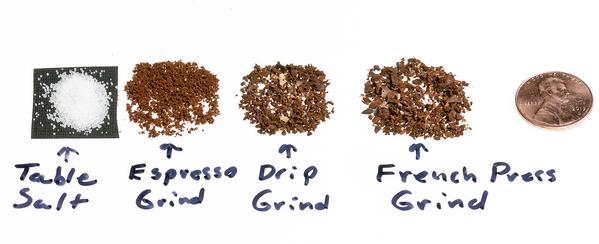

It's difficult to describe grind sizes. What exactly is coarse? Or fine? Grind size is relative, so the easiest way is to compare them visually. Above, the three grind sizes we tested are shown with table salt and a penny for reference. The espresso grind is really fine. It's finer than the table salt (though it looks similar), and almost feels like flour. The drip grind is much coarser than both the table salt and espresso grind. It's got a definite gritty feel between the fingers. Reminds me of the beach sand in Santa Cruz. This is also the grind we do most of our cold brews with. The coarsest of the three is something we use for our french press. It's definitely got some big chunks.
You'll notice that each grind does not consist of all the same sized particles. What we've got is a range of particle sizes with the "average" being our desired grind size. All coffee grinders (including the burr grinders we use) will produce a distribution of particle sizes. The only way to get a uniform grind size is to use a sieve to sort out the desired size. But it's not really necessary. As long as our grinder is producing a narrow particle size distribution (the vast majority of particles are close in size), having varying sized particles is no a significant problem. The most important thing is that we're getting consistency from grind to grind. Coffee grinding is a fascinating subject. Expect a future post on grinders where we'll dive more in depth.
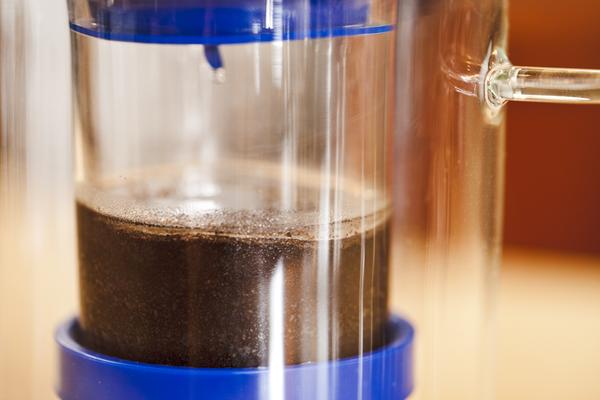

The Setup:
For each Cold Bruer, we used 50 grams of coffee and 600ml of water. This gives us the 1:12 brewing ratio that's been our go-to ratio anytime we're trying out a new coffee. We also set the drip rate to about 1 drip every 2-3 seconds. For these tests, we're using Verve's Streetlevel espresso blend. It's a coffee we've used extensively in the past for testing Cold Bruer.
The coarse grind was the quickest to begin dripping, and the fine grind was the slowest. The finer the grind, the more difficult it is for the water to begin passing through.
Water pooling above finely ground coffee bed
The fine grind was restricting the water so much that it began pooling up above the coffee bed! It never got more than 3-4mm deep, but we expect that it may have risen more had we used a faster drip rate
On to the good stuff! We set up a blind tasting of each brew, and jotted down our tasting notes on the post-it by each cup. After we were sufficiently caffeinated, we took some guesses about what cups had what cold brews, then we looked under the cups to see if we were right. The Fine brew was an easy one to pick out. The tasting notes for that one were "harsh", "bitter" and a "slight metallic taste". Not very pleasant in general. Everyting we'd expect from an over extracted brew.
The Medium and Coarse were a little more challenging to pick out. In the end, our guesses were correct. The Coarse had the familiar sweetness that we've come to love about cold brew, but it was less pronounced than in the Medium brew. While the Medium brew had a long lasting dark chocolate sweetness that stayed with you, the Coarse brew left the palate quickly: An indicator of under extraction.
Hands down, blind tasting is the best way to evaluate the quality of coffee. But it's sometimes nice to correlate some numbers with changes made in the experiment. Here's where the coffee refractometer comes in to play. It's a device that measures the total dissolved solids in the brew telling us the brew strength and giving an indicator of the extraction yield (how much was extracted from the coffee). The refractometer deserves a dedicated blog post of its own, but we'll give a quick run-down of the results.
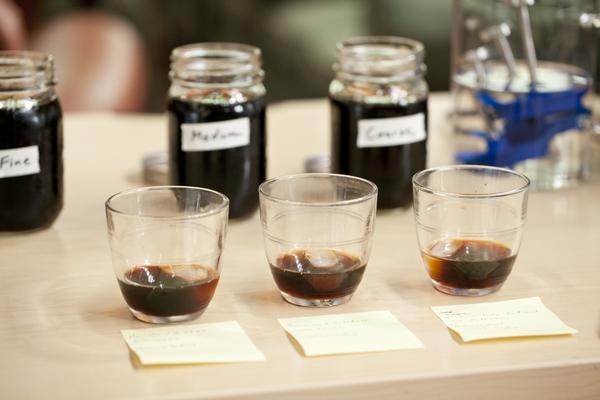

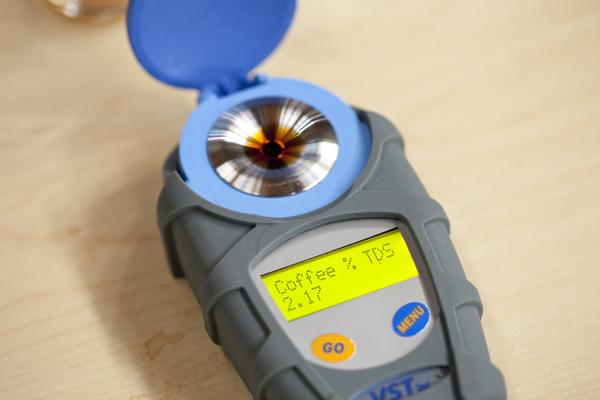

The Fine brew had 2.17% Total Dissolved Solids (TDS) correlating to a 23.76% extraction yield.
The Medium brew had 1.96% TDS correlating to a 21.46% extraction yield.
The Coarse brew had 1.86% TDS correlating to a 20.36% extraction yield.
These are the basic equations for determining the extraction yield of the coffee. There's a slick App that crunches the numbers called VST Coffee Tools from the same company that makes the refractometer, but sometimes it's nice to work it out on paper to see what's going on. The below numbers are for the fine brew. The 2.17% is the TDS measured with the refractometer, the 520g is the weight of the brewed coffee (we started with 600g of brew water, but about 80g of it was absorbed by the coffee bed). The dry mass is the mass of ground coffee, but you'll notice that 47.5g is used in the calculations when we had measured 50g of coffee. This reduced amount takes into account the moisture and CO2 content of the ground coffee (about 5% of the total mass) that will not contribute to the extraction.
There's been extensive research done to determine the ideal Brew Strength and Extraction range for conventional hot brewed coffee. The SCAA calls for a TDS range of 1.15%-1.35% and an extraction of 18%-22%. These values are the result of polling people's preference for coffee flavor and brew strength. Cold brew is relatively new, and there's little information on what the accepted standards are (though the only thing that really matters is what tastes good to you). From our experience, we've found that brew strengths above 2% tend to develop some bitterness, so it's no surprise that the fine grind brew at 2.17 had that harsh bitterness. We're looking forward to using the refractometer in future experiments to help build our quantitative understand of cold brew.


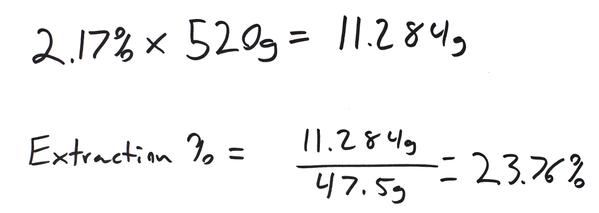

Conclusion
Grind size is definitely an important variable that will influence the quality of the cold brew. Grinding too fine will over extract leading to a harsh and bitter result. Too large of a grind and the brew is underdeveloped and weak. There's definitely a sweet spot for the grind size that will bring out the coffee's sweetness. A good starting point is to choose a grind that has the feel of sand and then adjust from there. If it's too weak/watery, try a finer grind. If it's tasting bitter, move to a coarser grind. Half the fun is experimentation, so enjoy!